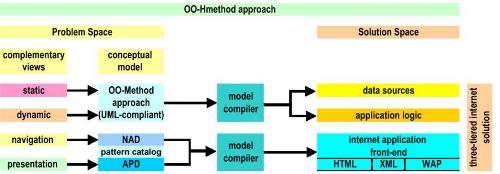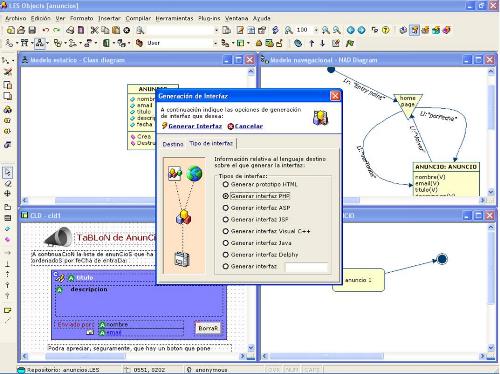Never miss an update from Universidad de Alicante
Create your free account to connect with Universidad de Alicante and thousands of other innovative organizations and professionals worldwide
The Web Engineering Group of the department of Languages and Information Systems at the University of Alicante has developed a pre-competitive method and an accompanying software tool to assist the design of device-independent Web Applications. This revolutionary software, based on standards for Information Systems Object Oriented analysis and design (UML, OCL, XML), supplies:
TECHNICAL DESCRIPTION
Existing tools intended to build and deploy engaging complex Web sites (including functionality) have shown to be inadequate to face the software production process in a unified and systematic way, from a precise system specification to the corresponding final implementation. In this context, where new technologies are continuously emerging, new approaches are required for the web developer to address the entire software lifecycle, from design to development to deployment to maintenance, in a way that is consistent, efficient and allows the specification of language-independent applications.

Figure 1: OO-H Method: An overview
To address this concern we have developed the Object-Oriented Hypermedia (OO-H) methodological proposal and their associate pre-competitive CAWE (Computer-Aided Web Engineering) Tool that, using an Object-Oriented approach, captures all the relevant properties involved in the modelling and implementation of Web Application Interfaces. The design process (see Figure 1) involves the construction of two additional views, complementary to those captured in traditional, UML-compliant, conceptual modelling approaches. These are, namely, the Navigation View, which extends a class diagram with hypermedia navigation features, and the Presentation View, in which the different elements regarding interface appearance and behaviour are modelled by a series of interconnected template structures, expressed in XML. As a result, a language-independent front-end specification is obtained. From there a web interface, which may be integrated with pre-existent logic modules and/or web services, can be generated in an automated way.
CAWE (Computer-Aided Web Engineering) Tool
The CAWE tool (see Figure 2) provides an operational environment that supports all the methodological aspects of OO-H Method. It simplifies the design and implementation of web-based Information Systems from an object-oriented perspective, providing a comfortable and friendly interface for elaborating the OO-H Method models. The most interesting contribution of this CAWE environment is its ability to generate the web application front-end for well-known industrial software development environments.

Figure 2: snapshot of the CAWE tool
TECHNOLOGY ADVANTAGES AND INNOVATIVE ASPECTS
1. Two new views to capture relevant user interface properties:
The OO-H method extends the traditional views – those that capture the static and dynamic properties of an application – with two new complementary diagrams. The navigational access diagram (NAD) defines a navigation view, and the abstract presentation diagram (APD) gathers the concepts related to presentation. Both the NAD and the APD capture the interface related design information with the aid of a set of patterns, defined in an interface pattern catalogue integrated in the OO-H method proposal.
2. Increased level of abstraction:
The OO-H method increases the level of abstraction at which Web interfaces are defined, and is therefore much closer to the conceptual space (domain problem) than other proposals.
3. Interface usability improvement:
Our approach is user centred (as it relies on user requirements) and object oriented. This fact allows the use of the knowledge domain implicit in object-oriented models to improve the interface usability. The inclusion of a pattern catalogue and the way these patterns are applied to the different diagrams to modify both the model and the final implementation are closely related to this usability concept and are one of the main contributions of our method.
4. Automatic Generation of prototypes close to the end application:
As a final result, our approach generates prototypes very close to the end application. Very low modifications are needed to get a fully functional version of the modelled application (web).
5. Easy integration:
The OO-H method centres on defining and integrating Web interfaces with existing business modules. As a result, the OO-H method specifically provides mechanisms for invoking services, selecting the possibly complex parameters to be passed to a given method, dealing with invocation errors, and so on. Finally, starting from a UML-compliant conceptual modelling approach facilitates the OO-H method’s integration with other proposals.
CURRENT STATE OF DEVELOPMENT
Nowadays, we own a prototype of a CAWE tool that, for a given Information System, allows us to capture the following properties:
+ The properties related to the contents (data and its structure).
+ The properties related to the appearance (data display).
+ The properties related to the user-system interaction process. These are further divided into:
- Navigation through information.
- Client logic.
- Connection process with legacy systems.
Based on these properties, the tool allows us to develop an operative implementation of the system using ASP, JSP or PHP technology.
This CAWE Tool is being used at this moment for the resolution of real web applications, in the context of R&D projects carried out jointly by the Web Engineering Group of the University of Alicante and a set of industrial partners.
The prototype is available for demonstration.
COLLABORATION SOUGHT
The Department of Information Systems and Languages of the University of Alicante is seeking for the following partners:
- End users and/or distributors interested in acquiring this technology.
-Partners willing to develop specific applications out of this technology, establish further research projects, submitting EU RTD proposals, etc.
Ahead of the current Coronavirus outbreak, Innoget is fully committed to contributing to mobilizing scientific and expert communities to find a real solution to the Covid-19 pandemic. Therefore, we're supporting worldwide calls and programs that could help in any aspects of the coronavirus crisis.
Is your organization promoting or looking for innovation or research initiatives to mitigate the Covid-19 outbreak? Email us at covid19@innoget.com to list them.
Channeled through Innoget's online open innovation network, initiatives in the health, virology, medicine, or novel technologies applied to human health, among others, are listed and disseminated to Innoget members -ranging from hospitals, research institutes, scientists, businesses, and public administrations- and innovation partners worldwide.
Create your free account to connect with Universidad de Alicante and thousands of other innovative organizations and professionals worldwide
Send a request for information
to Universidad de Alicante
Technology Offers on Innoget are directly posted
and managed by its members as well as evaluation of requests for information. Innoget is the trusted open innovation and science network aimed at directly connect industry needs with professionals online.
Need help requesting additional information or have questions regarding this Technology Offer?
Contact Innoget support